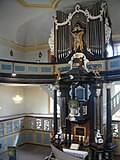Förster & Nicolaus organ building
| Förster & Nicolaus organ building | |
|---|---|
| legal form | GmbH & Co. KG |
| founding | 1842 |
| Seat | Lich , Germany |
| management | Martin Muller |
| Branch | Musical instrument making |
| Website | foerster-nicolaus-orgelbau.de/ |
Förster & Nicolaus Orgelbau is an organ building company in Lich . It was founded in 1842 by Johann Georg Förster and was run as a family business for four generations until 1988. Then Martin Müller and Joachim Müller took over the management. Martin Müller has been the sole company director since 2017. The list of works includes more than 700 new buildings and numerous restorations.
history
Johann Georg Förster had learned his trade from leading organ builders and set up his own workshop in Lich in 1842. He was the successor to Johann Georg Bürgy from Gießen, who died in 1841 without a successor. Foresters built alongside the traditional mechanical slider chests and cone chests and hanging valve shop . An organ in Butzbach was equipped with a flap valve shutter , a new type of pneumatic system that H. Dietz and C. Nicolaus patented on November 16, 1892 (patent specification No. 72546). Characteristic for Förster's style were transmission shutters with double loops.
Carl Nicolaus (born November 9, 1860 in Steinbach near Gießen; † October 24, 1929 in Lich) was a journeyman in the company from 1884, married Förster's daughter Louise (1862–1956) in 1889 and initially became a partner, from 1900 even the sole owner the company, which has now been renamed "Förster und Nicolaus". Nicolaus further developed the pneumatic action, which was introduced in the form of tube pneumatics in a newly developed form as a new invention from 1892, but proved to be unreliable. Another new form with free-floating and downward-opening valves did not prevail either, so that the company returned to the pneumatic cone drawer in 1900. This tractor system was retained until the beginning of the 1920s. In the case of new organs, only the historical brochures were often included.
Ernst Nicolaus (born April 23, 1897 in Lich; † August 26, 1966 ibid) and his brother Karl (born May 5, 1891 in Lich; † May 28, 1924 ibid) became partners in the company in 1923 and built 127 harmonies by 1927 . From 1927 Otto Heuss became plant manager. He started his own business in 1953 in Lich and specialized as a supplier in the construction of console tables and other organ parts. After the death of his father, Ernst Nicolaus ran the company from 1929 in the third generation. The organ movement had a lasting influence on the dispositions since the 1930s . Fritz Abend, who was artistic director and voicer at Eule and who was involved in the restoration of Gottfried Silbermann's organs , joined the Lich company in 1947. He worked with Helmut Walcha and advocated the retention of historical actions and refused pneumatic conversions. The electric cone drawer found its way into new buildings close to the Second World War and was used until the 1960s. From 1951 the first positive organs with mechanical sliding chests were built, from 1953 smaller and from 1960 also larger organs.
Manfred Nicolaus (born April 25, 1926 in Lich; † March 1, 2014), son of Ernst Nicolaus, learned organ building in his father's workshop and immersed himself in Mönch (Überlingen) and Åkerman & Lund (Stockholm). He joined the company as a partner in 1960 and took over the management from 1966 to 1988. He introduced the historically oriented organ building, which Nicolaus had got to know in Sweden, in new organs and in restoration projects that preserve the substance. Under his leadership, the unrelated Joachim (Jochen) Müller (born March 7, 1959 in Büdingen; † February 1, 2017) in 1974 and Martin Müller (born October 8, 1958 in Sellnrod) began their apprenticeship in organ building in 1976. Jochen Müller trained with Rudolf von Beckerath and the two at the Giesecke company . Study trips to important European organ landscapes followed . In 1986 they both passed their master craftsman exams and in 1988 took over the company in equal parts. This section of the company's history is mainly characterized by the restoration of historic organs and less by new buildings. After the death of Joachim Müller, the company is managed by Martin Müller.
After the area of activity initially extended to Rheinhessen and Upper Hesse, after the Second World War it was expanded to include the areas around Mainz, Frankfurt am Main and Wiesbaden. In 2017, the company had 13 employees and around 1,000 maintenance contracts. Since it was founded, over 700 new buildings have been built and numerous historic organs have been restored. The company works with around 1000 contract partners.
List of works (selection)
The size of the instruments is indicated in the sixth column by the number of manuals and the number of sounding registers in the seventh column. A capital “P” stands for a separate pedal. Italics indicate that the organ in question is no longer or only the prospectus has been preserved.
Instruments made before 1900 by Johann Georg Förster can be found in his article.
New buildings and extensions
| year | opus | place | building | image | Manuals | register | Remarks |
|---|---|---|---|---|---|---|---|
| 1902 | Fellingshausen | Protestant church | I / P | 7th | New building with spring wind chest | ||
| 1904 | 105 | Butzbach | St. Mark's Church |

|
II / P | 25th | New building with pneumatic cone drawer |
| 1906 | Mommenheim (Rheinhessen) | Ev. church | II / P | 13 | |||
| 1908 | 125 | Loan yesterday | Protestant church |

|
II / P | 17th | romantic disposition, pneumatic cone shop; completely preserved |
| 1908 | 127 | Great Linden | Protestant church |

|
II / P | 20th | |
| 1913 | Alsfeld | Walpurgis Church |
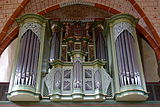
|
II / P | 35 | in baroque case, replaced in 1982 | |
| 1914 | Essenheim | Evangelical Mauritius Church | II / P | 13 (14) | New organ building using prospectus parts from the previous organ (presumably by Johann Georg Dreuth or Onimus before 1752), expert Mendelssohn, lateral flat panels added to the three-axis prospectus, pneumatic cone chests, manuals C – g3, pedal C – d 1 , HW: Principal 8 ′, Flute 8 ′, gamba 8 ′, octave 4 ′, reed flute 4 ′, rush fifth 2 2 ⁄ 3 ′ +2 ′. SW: violin principal 8 ′, lovely set 8 ′, aeoline 8 ′, voix celestis 8 ′, flauto dolce 4 ′. Pedal: sub-bass 16 ′, principal bass 8 ′ (still-dumped bass 8 ′ as transmission), II / I, I / P, II / P, sub and super octave coupler; 1995 dismantled and stored. | ||
| 1925 | Langsdorf (Lich) | Evangelical Reformed Church |

|
II / P | 19th | in the late romantic style, pneumatic cone chests | |
| 1926 | Heuchelheim (Hesse) | Martinskirche |

|
II / P | 13 (14) | behind the historical prospectus by Johann Christian Köhler (1755, attribution) | |
| 1928 | Reinheim | Evangelical Trinity Church | II / P | 19th | |||
| 1931 | Frankfurt-Niederrad | Paul Gerhard Church | II / P | 28 | |||
| 1932 | Mainz-Amöneburg | Gustav-Adolf-Gedächtniskirche | II / P | 17th | |||
| 1938 | slot | City Church |

|
II / P | 21st | New building with electric cone store including the baroque organ prospect of the previous organ from 1719; 1968 Extension conversion to II / P / 22 with electric sliding drawers. | |
| 1948 | Dietzenbach | Christ Church | II / P | 13 | New building including the prospectus and parts of the pipework of the predecessor organ by Adam Karl Bernhard (1891), which was badly damaged in 1941 | ||
| 1953 | Mornshausen (Gladenbach) | Protestant church |
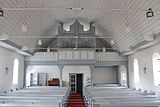
|
I / P | 7th | ||
| 1955/1956 | Frankfurt am Main | Heilandskirche |

|
II / P | 25th | In 2006 the organ was sold to St. Albertus (Gießen) (photo) due to the demolition of the Heilandskirche . | |
| 1957 | to water | Justus Liebig University , auditorium | II / P | 25th | |||
| 1958 | Frankfurt am Main | Large broadcasting hall of the Hessischer Rundfunk |

|
III / P | 56 | electropneumatic cone store | |
| 1949–1951/1961 | Herford | Herford Cathedral | IV / P | 57 | New building using older registers, extension by a Rückpositiv in 1961 | ||
| 1960 | Oberursel (Taunus) | St. Ursula |

|
II / P | 21st | New building behind the prospectus by Johann Conrad Bürgy (1789–1793) | |
| 1960 | Watzenborn-Steinberg | Christ Church |

|
II / P | 18th | New building; Pedal wing with wooden pipes in the brochure | |
| 1960-1961 | Mainz | St. Johannis | III / P | 40 | New building | ||
| 1962 | Mainz | Christ Church |

|
III / P | 44 | New building | |
| 1963 | Wiesbaden-Schierstein | Christophoruskirche | II / P | 21st | New building | ||
| 1964 | Alsfeld | Trinity Church | II / P | 26th | Main work and pedal on the second gallery above the positive | ||
| 1965 | to water | St. Boniface |

|
III / P | 42 | New building; Replaced in 2015 | |
| 1965 | Great Linden | Christ-King |

|
II / P | 22nd | ||
| 1966 | Frankfurt-Sachsenhausen | St. Wendel |

|
III / P | 31 | Disposition based on a design by Helmut Walcha ; 1989 Reorganization by Fischer & Krämer , 2002 Principal 16 ′ (bass octave in the pedal) added, 2008 new typesetting system | |
| 1968 | to water | Johanneskirche |

|
III / P | 42 | New building | |
| 1968 | to water | Petruskirche | III / P | 33 | New building; Hauptwerk protrudes into the church space in a right-angled form on a gallery peak | ||
| 1968 | Holzheim (Pohlheim) | Evangelical Reformed Church |

|
II / P | 13 | behind the historical prospectus by Johann Hartmann Bernhard (1829) | |
| 1969 | Grünberg (Hesse) | Evangelical town church |

|
II / P | 23 | ||
| 1969 | Snake bath | Christ Church | II / P | 18th | New building behind the historical prospectus by Link (1908) | ||
| 1972 | Lich | Marienstiftskirche Lich |

|
III / P | 33 | General renovation behind the historical prospectus by Georg Wagner (1621–1624) using the existing register inventory | |
| 1973 | Frankfurt-Sossenheim | Evangelical Church Sossenheim |

|
II / P | 18th | ||
| 1977 | Heuchelheim (Hesse) | Ev. church |

|
II / P | 21st | ||
| 1977 | Lang-Göns | James Church |

|
II / P | 19th | New building to replace the organ from 1920 by Förster & Nicolaus | |
| 1979 | Arnsburg Monastery | paradise |

|
I / P | 8th | behind the historical prospectus and including a pedal register from the church of Bindsachsen , the manual keyboards and two old registers from the Gedern church and another old register from the Holzheim church | |
| 1981 | Erbach (Rheingau) | St. Mark | II / P | 27 | New building behind the prospectus by Johannes Kohlhaas the Elder (1725); with coupling manual | ||
| 1983 | Frankfurt am Main | St. Jacob's Church | II / P | 22nd | New building | ||
| 1984-1986 | Frankfurt-Bergen-Enkheim | St. Nicholas Church | IV / P | 52 | 1992 addition of a base 32 ′ from the broken off Walcker organ of the Katharinenkirche (Frankfurt am Main) ; 1997 new setting machine | ||
| 1989 | 670 | Bad Homburg vor der Höhe | Castle Church |
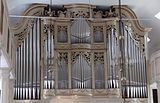
|
III / P | 38 | Reconstruction behind the historical prospectus by Johann Conrad Bürgy |
| 1992/93 | 694 | Bad Homburg vor der Höhe | Church of the Redeemer |
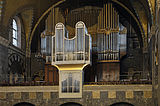
|
IV / P | 62 | Expansion of the organ by Wilhelm Sauer with a romantic-symphonic Récit → organ |
| 1995 | 702 | Schwetzingen | City Church | II / P | 27 | New building | |
| 1995 | 705 | Polch | St. Stephan | III / P | 41 | New building | |
| 1997 | Worms | Luther Church | III / P | 40 | Renovation and extension of the organ by Gebr. Link (1963) | ||
| 1999 | 715 | Stadtallendorf | St. Michael |

|
II / P | 25th | New building |
| 2000 | 717 | Erftstadt- Liblar | Ev. Friedenskirche | II / P | 14th | New building, 7 registers on alternating loops | |
| 2002 | 720 | Homberg (Ohm) | City Church |

|
II / P | 19th | New building |
| 2005 | 724 | Dausenau | St. Castor |
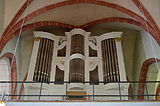
|
II / P | 21st | New building behind the prospectus by Johann Daniel Buderus (1841) |
| 2010 | 727 | Koblenz | Florin's Church |

|
III / P | 51 | New building |
Restorations
| year | opus | place | building | image | Manuals | register | Remarks |
|---|---|---|---|---|---|---|---|
| 1978 | Nieder-Moos | Ev. church |

|
II / P | 22nd | Restoration of the organ by Johann-Markus Oestreich (1790/91) → Organ of the Evangelical Church in Nieder-Moos | |
| 1984 | Ensheim | Ev. church | I / P | 9 | Restoration of the Stumm organ (1745) | ||
| 1988 | Mettenheim (Rheinhessen) | Ev. church | II / P | 23 | Restoration of the Stumm organ (1762) | ||
| 1991 | Mainz | Augustinian Church |

|
II / P | 35 | Restoration of the Stumm organ (1773) | |
| 1990-1992 | Ohrdruf | Trinity Church | II / P | 34 | Restoration of the organ by Georg Franz Ratzmann (1814) | ||
| 1992 | Burgholzhausen in front of the height | Holy cross | Restoration of the organ by Bernhard Dreymann (1836) | ||||
| 1998 | Alzey | Little church |
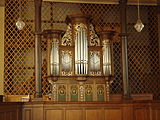
|
II / P | 21st | Restoration of the Stumm organ (1737) | |
| 1997-1999 | Weather | Collegiate church |
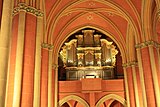
|
II / P | 25th | Restoration / reconstruction of the organ by Johann Andreas Heinemann (1766) and addition of three pedal stops on a separate drawer | |
| 2002-2004 | Altenberg Monastery | Monastery church | II / P | 23 | Repair of the organ by Johann Wilhelm Schöler (1757/58) → organ of the Altenberg monastery | ||
| 2004 | Kirchberg (Lahn) | Ev. church | I / P | 13 | Restoration of the organ by Johann Andreas Heinemann (1777) | ||
| 2006 | Mother city | Ev. Parish church | II / P | 22nd | Restoration of the Stumm organ (1785–1786) | ||
| 2010 | 726 | Laubach | Evangelical town church |

|
III / P | 31 (33) | Restoration / reconstruction; Prospectus and 9 registers from Johann Casper Beck / Johann Michael Wagner / Johann Andreas Heinemann (1747–50) preserved |
| 2011–2012 | Bad Sobernheim | Catholic parish church |

|
II / P | 20th | Restoration of the organ by Michael Körfer (1901/1902); Manufacture of a new gaming table, the historical registration plates were retained | |
| 2012-2013 | Pfungstadt | Ev. church |

|
II / P | 26th | Restoration of the largest organ by Johann Hartmann Bernhard (1825), of which 15 stops have been preserved | |
| 2013 | Salt soils | Ev. church | I / P | 11 | Renovation of the organ by Günter Hardt (1961) behind the rococo case from around 1760 | ||
| 2014-2015 | Bechtolsheim | Simultaneous church |
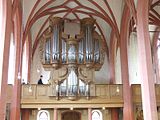
|
II / P | 28 | Restoration of the organ by Johann Philipp & Johann Heinrich Stumm ; Much preserved → organ | |
| 2015 | Trebur | Laurentiuskirche | II / P | 28 | Restoration of the organ by Bernhard Dreymann (1844) | ||
| 2016 | Bärstadt | Martinskirche | II / P | 22nd | Restoration of the Stumm organ (1769–1771) | ||
| 2017 | Rudigheim | Ev. church | I / P | 12 | Restoration and reconstruction of the organ by Johann Georg Zinck (1789) | ||
| 2018 | Diedenbergen | Ev. church | II / P | 17th | Restoration of the organ by Johann Conrad Bürgy (1768) | ||
| 2018-2020 | Ilbenstadt | Ilbenstadt Monastery , minor basilica |

|
II / P | 30th | Restoration and reconstruction of the organ by Johann Onimus (1733–1735) | |
| 2019-2020 | Wonsheim | Lambertus Church | I / P | 14th | Restoration and reconstruction of the Stumm organ (1818) |
See also
literature
- Hans Martin Balz : 175 years of Förster & Nicolaus. In: Ars Organi . 65, 2017, pp. 7-16.
- Hans Martin Balz: organs and organ builder in the area of the former Hessian province of Starkenburg. A contribution to the history of organ building . (= Studies on Hessian music history. 3). Görich & Weiershäuser, Marburg 1969.
- Franz Bösken : Förster and Nicolaus. In: Music in the past and present . Vol. 16. Bärenreiter, Kassel 1979, ISBN 3-89853-160-0 , pp. 319-320 (CD-Rom edition of the 1st edition, Directmedia, Berlin 2003).
- Franz Bösken: Sources and research on the organ history of the Middle Rhine (= contributions to the Middle Rhine music history . Volume 7.2 ). tape 2 : The area of the former administrative district of Wiesbaden. Part 2: L-Z . Schott, Mainz 1975, ISBN 3-7957-1370-6 .
- Hans-Joachim Falkenberg: Epochs in the history of the organ. Förster and Nicolaus 1842–1992. Organ building specialist publisher Rensch, Lauffen 1992, ISBN 3-921848-24-5 .
- Hermann Fischer : 100 years of the Association of German Organ Builders . Orgelbau-Fachverlag, Lauffen 1991, ISBN 3-921848-18-0 , pp. 185-186.
Web links
See also
Individual evidence
- ↑ Hermann Fischer: 100 Years of the Association of German Organ Builders . Orgelbau-Fachverlag, Lauffen 1991, ISBN 3-921848-18-0 , p. 185.
- ^ Falkenberg: Epochs of Organ History. 1992, p. 68.
- ^ A b Franz Bösken: Förster and Nicolaus . In: Music in the past and present . Vol. 16. Bärenreiter, Kassel 1979, ISBN 3-89853-160-0 , p. 319.
- ^ Balz: 175 years of Förster & Nicolaus. 2017, p. 12.
- ↑ a b Balz: 175 years of Förster & Nicolaus. 2017, p. 13.
- ↑ Homepage foerster-nicolaus-orgelbau.de: Company history , accessed on August 21, 2017.
- ↑ a b Balz: 175 years of Förster & Nicolaus. 2017, p. 15.
- ↑ Homepage foerster-nicolaus-orgelbau.de: list of works , accessed on August 21, 2017.
- ^ Organ town church Schlitz. Organ database Netherlands. Retrieved August 17, 2017 .
- ^ Organ in Gießen, St. Albertus , accessed on August 21, 2017.
- ^ Organ in Herford , accessed on August 21, 2017.
- ^ Bösken: Sources and research on the organ history of the Middle Rhine. Vol. 2, Part 2: L – Z. 1975, pp. 696-702.
- ^ Organ in Schlangenbad , accessed on August 21, 2017.
- ^ Bösken: Sources and research on the organ history of the Middle Rhine . Vol. 2: L-Z. 1975, p. 742.
- ^ Organ in Alzey , accessed on August 21, 2017.
- ↑ The Stumm-Organ of the Protestant Church in Mutterstadt , accessed on August 21, 2017 (PDF file; 1.7 MB).
- ^ Bösken: Sources and research on the organ history of the Middle Rhine. Vol. 1. 1967, pp. 249-251.
- ^ Organ in Bärstadt , accessed on August 21, 2017.
- ^ Organ in Rüdigheim , accessed on August 21, 2017 (PDF).
- ↑ Krystian Skoczowski : The organ builder family Zinck. A contribution to the research of organ building in the Wetterau and the Kinzig valley in the 18th century. Haag + Herchen, Hanau 2018, ISBN 978-3-89846-824-4 , pp. 33, 295.






